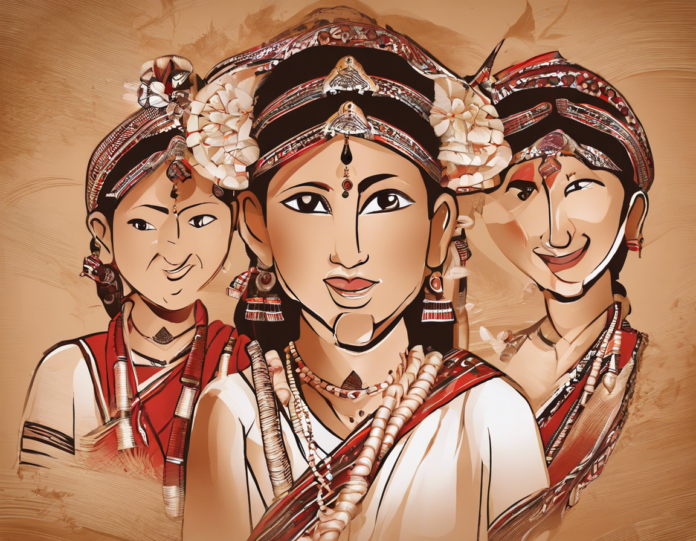Introduction
Magh Bihu, also known as Bhogali Bihu, is one of the most vibrant and popular festivals celebrated in the northeastern state of Assam, India. It marks the end of the harvest season in the Assamese calendar month of Magh, usually falling in January. The festival is a time for communities to come together, rejoice, and indulge in feasting, music, and traditional customs. In this comprehensive guide, we will delve into the traditions and festivities associated with Magh Bihu in Assam.
Bihu Celebrations
1. Chot Bihu (Uruka)
The celebrations kick off with Chot Bihu, also known as Uruka. This day is dedicated to preparing for the main festival and involves cleaning the household, decorating with traditional motifs known as Alpana, and preparing special dishes like Pitha, Laru, and Jolpan.
2. Magh Bihu (Bhogali Bihu)
Magh Bihu, the main day of celebration, is synonymous with feasting and community bonfires known as Meji or Bhelaghar. People gather around the bonfire, sing traditional Bihu songs, and engage in cultural activities throughout the night. The feast includes traditional Assamese delicacies like Pitha, Laru, Xutuli (a dish made of rice flour and jaggery), and Masor Tenga (sour fish curry).
3. Goru Bihu
The day following Magh Bihu is known as Goru Bihu, where cattle, especially cows, are given a ceremonial bath and adorned with garlands made of Tora leaves. This day is a gesture of gratitude towards the livestock for their contribution to agriculture.
4. Manuh Bihu
The final day of Bihu celebrations, Manuh Bihu, is dedicated to visiting friends and family, seeking blessings from elders, and exchanging gifts. It is a day of merriment and joy, symbolizing unity and togetherness within the community.
Traditional Customs and Rituals
1. Meji Construction
A significant ritual during Magh Bihu is the construction of Meji, a makeshift structure made of bamboo, thatch, and leaves. The Meji is set ablaze on the night of Magh Bihu as a symbol of burning away the past and welcoming the new harvest season.
2. Traditional Attire
During Magh Bihu, men and women dress in traditional Assamese attire. Men wear Gamosa, Dhoti, and Kurta, while women don Mekhela Chador or Saree, adorned with traditional Assamese jewelry like Jethi, Jonbiri, and Loka Paro.
3. Music and Dance
Bihu is incomplete without melodious Bihu songs and energetic dance performances. Musicians play the Dhol, Pepa, and Gogona, while dancers perform the rhythmic Bihu Naas (dance) around the bonfire, adding to the festive fervor.
Evolving Traditions
Over the years, the celebrations of Magh Bihu have evolved to incorporate modern trends while preserving the essence of traditional customs. Youngsters participate in cultural programs, competitions, and events to keep the spirit of Bhogali Bihu alive for future generations.
Eco-Friendly Celebrations
In recent times, there has been a shift towards eco-friendly celebrations of Magh Bihu, with initiatives to promote sustainable practices like using organic materials for Meji construction, avoiding plastics, and preserving the environment while reveling in the festivities.
FAQs (Frequently Asked Questions)
1. What is the significance of Magh Bihu in Assam?
- **Answer**: Magh Bihu holds immense cultural and agricultural significance in Assam, marking the end of the harvest season and symbolizing prosperity and abundance.
2. What are the key rituals of Magh Bihu celebrations?
- **Answer**: The key rituals include Meji construction, community bonfires, feasting on traditional Assamese delicacies, and honoring cattle on Goru Bihu.
3. How long does Magh Bihu celebrations typically last?
- **Answer**: Magh Bihu celebrations span over a period of three days, starting with Chot Bihu, followed by Magh Bihu and concluding with Manuh Bihu.
4. What are some traditional dishes prepared during Magh Bihu?
- **Answer**: Popular dishes include Pitha, Laru, Xutuli, Masor Tenga, and various sweet delicacies made from rice flour, coconut, and jaggery.
5. How do people decorate their homes during Magh Bihu?
- **Answer**: Homes are adorned with Alpana, traditional motifs created using rice flour and colored powders, to welcome prosperity and good luck during the festival.
6. Is Magh Bihu celebrated only in Assam?
- **Answer**: Magh Bihu is primarily celebrated in Assam, but similar harvest festivals are observed in other northeastern states under different names and traditions.
Conclusion
Magh Bihu stands as a testament to the rich cultural heritage and agricultural prosperity of Assam. The festival encapsulates the spirit of unity, gratitude, and joy, bringing communities together to celebrate the bounties of nature and usher in a new beginning. As the traditions of Bhogali Bihu continue to evolve with time, the essence of togetherness and festive cheer remains at the heart of this vibrant celebration in Assam.
